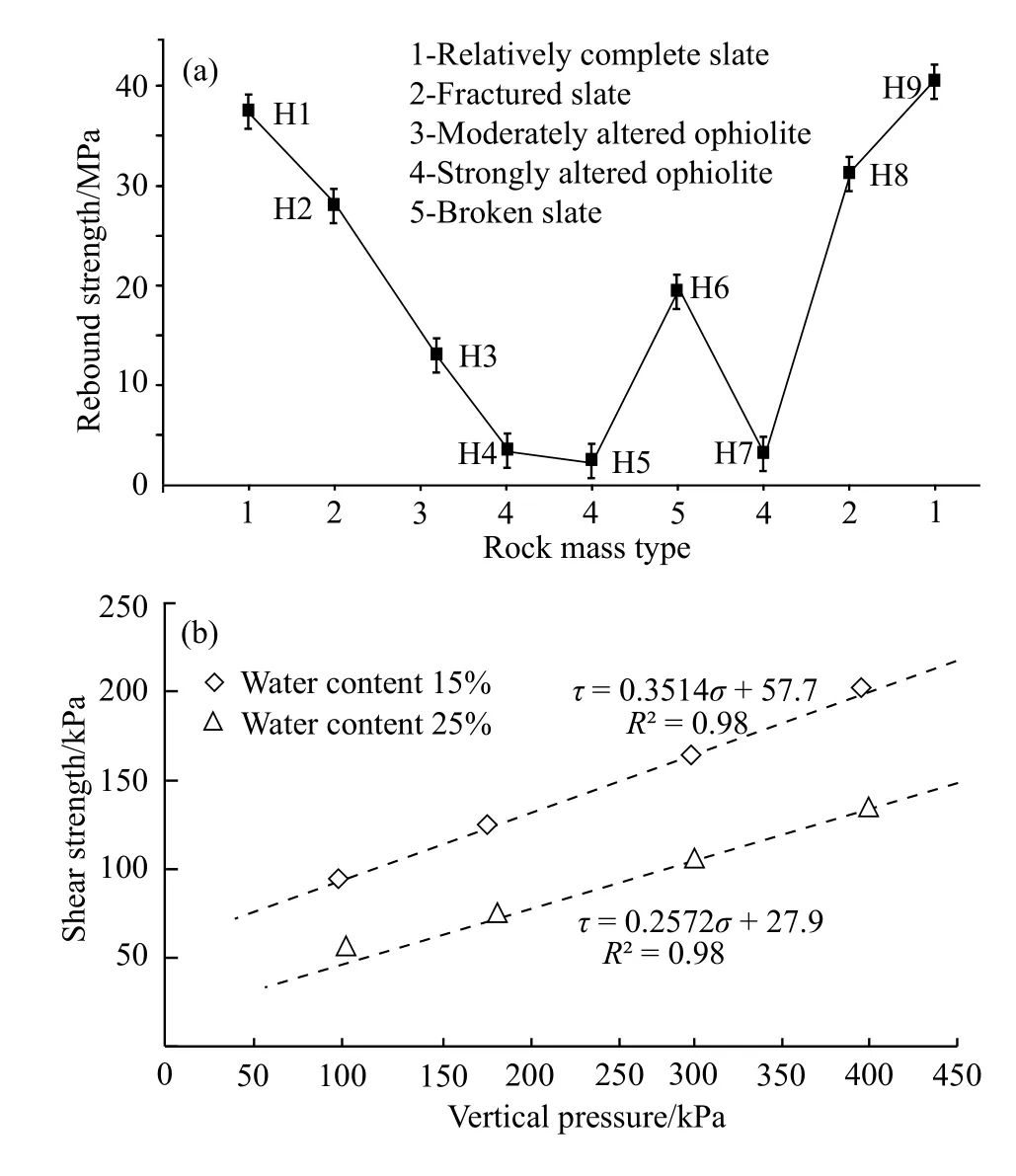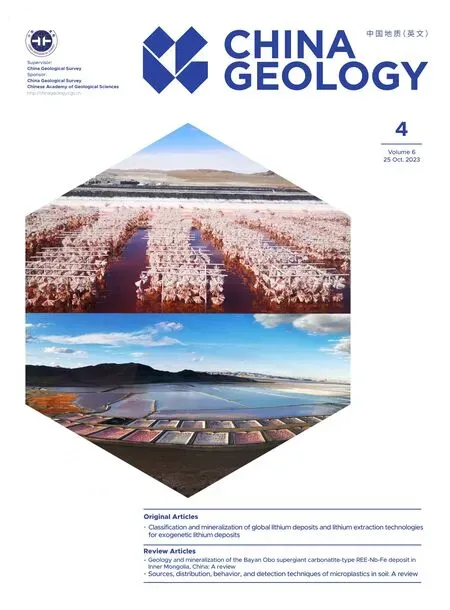Identification of clayey altered ophiolite in the Nujiang tectonic belt and new understanding of its impacts on engineering stability
2023-12-15JinqiuLiYongshungZhngXueLiSnshoRenLiRn
Jin-qiu Li, Yong-shung Zhng, Xue Li, Sn-sho Ren, Li-n Rn
a China University of Geosciences, Beijing 100083, China
b Institute of Hydrogeology and Environmental Geology, Chinese Academy of Geological Sciences, Shijiazhuang 050061, China
c Institute of Geomechanics, Chinese Academy of Geological Sciences, Beijing 100081, China
1.Objectives
Ophiolites from the oceanic crust are important indicators for identifying tectonic suture zones.Recently, a continuous ophiolite belt was found near the Guola Mountain in the Nujiang tectonic belt.Due to intensive hydrothermal alteration during tectonic evolution, clayey altered ophiolite with special engineering geological characteristics was formed, which has an extremely adverse impact on engineering stability.However, the adverse properties of clayey altered ophiolite are still not well understood in engineering practices (Zhang YS, et al., 2011).
This paper reports the distribution characteristics of the ophiolite belt near the Guola Mountain on the east Tibetan plateau of China, as well as its engineering geological properties.The potential impacts of clayey altered ophiolite on the stability of slopes and tunnels are discussed, providing helpful guidance for the prevention and control of related geosafety risks.
2.Methods
The distribution scope and geological characteristics of the ophiolite belt were investigated by field investigation,drilling, and unmanned aerial vehicle mapping.The clay particle content, clay mineral composition, and alteration degree of ophiolite were determined through grain size analysis, X-ray diffraction (XRD), and disintegration tests respectively.In siturebound tests and laboratory direct shear tests were conducted to obtain the UCS of the altered ophiolite and the shear strength of the altered clay.
3.Results
3.1. Geological characteristics of the ophiolite belt
According to the previous studies (Pan GT et al., 2020),the ophiolite outcrop near the Guola Mountain was mainly found at the right bank of the Nujiang River in a lens-shaped distribution, and no ophiolite outcrops were revealed at the left bank.Based on field surveys and drilling data, several typical ophiolite outcrops were found at both banks of the Nujiang River (width of about 290 m), the top of the Guola Mountain (width of about 242 m), the northwest slope of the Guola Mountain (width of about 40 m), and the right bank of the Exue River (width of about 20 m) (Fig.1).The total length of these outcrops reaches 3.4 km, exhibiting a continuous ophiolite belt that gradually narrows from south to north.
In the northwest slope of the Guola Mountain, the ophiolite belt consists mainly of serpentinized peridotite,appearing in dark, ink-green pseudobanded texture, contacting with dark grey slate and marble.A large number of joints and cleavages are developed in the ophiolite belt, displaying a layered fractured structure with intense compression and folding deformation.The ophiolites generally underwent different degrees of clayey alteration.Highly altered ophiolites usually appear in strip- or lens-shaped interlayers along joints, with thicknesses of 5-35 cm.
3.2. Engineering properties of altered ophiolite
Clay mineral composition.The XRD test results indicate that the clay particle content ranges from 20% to 30%, and the clay mineral content ranges from 73% to 93%.The clay minerals were formed due to hydrothermal alteration of serpentinite (Ji SC et al., 2018; Fig.2a).The altered clay is mainly composed of montmorillonite, followed by illite/smectite mixed-layer minerals (Fig.2b).Therefore, the altered ophiolite with thick clay interlayers may exhibit significant expansion due to water absorption, as well as water loss-induced shrinkage.
Disintegration durability.Clayey altered rocks are rich in hydrophilic minerals such as montmorillonite and illite/smectite mixed-layer minerals, leading to poor durability and disintegration under alternate wetting and drying.They can transform into a muddy state after experiencing multiple or even a single episode of water immersion (Fig.2c).On site,accumulation of debris formed due to disintegration is often observed at a slope foot or in clogged drainage channels.Additionally, saddle-like landforms are often formed at mountain tops composed of clayey altered serpentinite.
Mechanical properties.Rebound tests on ophiolite along the northwest slope of the Guola Mountain indicated that the strength of altered ophiolites decreases with increasing alteration degree, and the UCS generally falls below 5 MPa(Fig.3a).Direct tests on altered clay from Jiba Village at the right bank of Nujiang River revealed that the strength is generally low, which is significantly influenced by water content.When the water content is 15%-25%,φis 14.3°-19.4°, andcis 28-58 kPa (Fig.3b).
3.3. Impact on Engineering Stability
Impact on slope stability.When the altered ophiolite forms a slope, the altered clay interlayers along joints may promote the expansion of discontinuous planes and gradually become a sliding-prone geo-structure.Significant strength weakening and rock structure deterioration occur when the altered ophiolite is exposed to water, which may lead to largescale landslides.Landslides with such structures are commonly found in the Nujiang tectonic belt, such as the landslides on the right bank of the Nujiang River and the Dorasi landslide in Basu County (Zhang YS et al., 2022).
Impact on tunnel stability.When tunnelling in altered ophiolites, typical characteristics of weak rock formations are encountered.Due to its association with the Nujiang Fault,three sets of joints are prevalently developed in the ophiolite belt, and there are often mud-covered gravels or altered clay interlayers along joints.Such surrounding rock of a tunnel is generally classified as Grade V according toChinese Standard for Engineering Classification of Rock Mass(GB/T 50218).When the surrounding rock is rich in water, it can be worse than Grade V.Consequently, tunnel construction in altered ophiolites may encounter the following problems:large-scale roof caving and collapse along the densely jointed zone above the tunnel, inward deformation or sudden caving of tunnel sidewall, tunnel floor heave in water-rich areas, etc.

Fig.2.XRD spectrum of whole rock (a) and altered clay (b), and disintegration test of altered rock (c).

Fig.3.Strength characteristics of altered ophiolite.a-average rebound strength of the ophiolite belt on the northwest slope of the Guola Mountain.b-shear strength of altered clay on the right bank of the Nujiang River.
4.Conclusions
(i) The ophiolite belt near the Guola Mountain extends for approximately 3.4 km with a strip-shaped distribution.The altered ophiolite is a special rock type with the worst engineering geological characteristics in the Nujiang tectonic belt, making it highly prone to geosafety risks.
(ii) The slope in the altered ophiolite belt should be reinforced with support protection and drainage at the slope foot, so as to avoid the deterioration of rock mass due to exposed slope surface and alternate wetting and drying, and subsequent large-scale slope failure.
(iii) During tunnel construction in the ophiolite belt, it is important to minimize engineering disturbances and adopt rapid construction and support techniques.After tunnel completion, long-term monitoring of the surrounding rock deformation should also be implemented.
Fund support
Supported by the National Natural Science Foundation of China (41941017) and the Fundamental Research Funds for the Central Public Research Institutes (SK202109).
杂志排行
China Geology的其它文章
- Melt extraction and mineralization: A case study from the Shuangjianzishan supergiant Ag-Pb-Zn deposit (208 Mt), Inner Mongolia, NE China
- Health risk assessment of heavy metals in soils and crops in a mining area (Au-Ag-Cutrona-oil et al.) of the Nanyang Basin, Henan Province, China
- Classification and mineralization of global lithium deposits and lithium extraction technologies for exogenetic lithium deposits
- A three-dimensional Moho depth model beneath the Yemeni highlands and rifted volcanic margins of the Red Sea and Gulf of Aden, Southwest Arabia
- Heavy metal pollution assessment in marine sediments in the Northwest coast of Sabah,Malaysia
- Reply: Comment on “Geological mapping and mining prospecting in the Aouli inlier(Eastern Meseta, Morocco) based on remote sensing and geographic information systems (GIS)” by Benaissi et al.(China Geology, 5 (2022))
